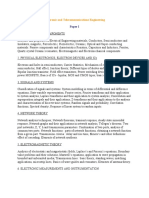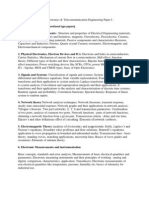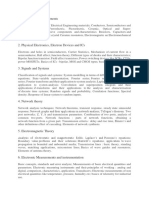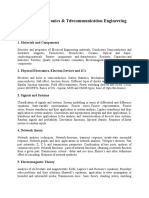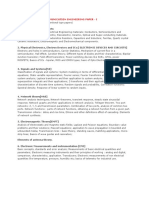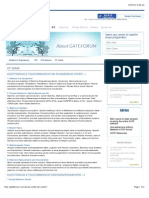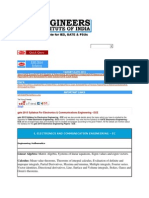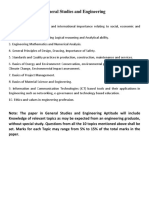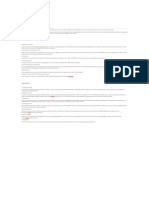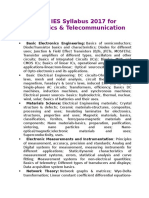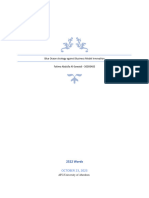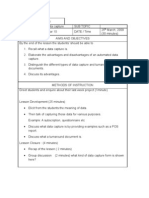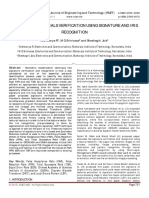Target-GATE: Tell Your Friends
Target-GATE: Tell Your Friends
Uploaded by
Ath SydCopyright:
Available Formats
Target-GATE: Tell Your Friends
Target-GATE: Tell Your Friends
Uploaded by
Ath SydOriginal Title
Copyright
Available Formats
Share this document
Did you find this document useful?
Is this content inappropriate?
Copyright:
Available Formats
Target-GATE: Tell Your Friends
Target-GATE: Tell Your Friends
Uploaded by
Ath SydCopyright:
Available Formats
Home About Courses Fee Facility FAQ Career Contact Blog
Target-GATE
About GATE Exam GATE 2013 Eligibilty GATE 2013 Pattern GATE 2013 Syllabus GATE 2013 Schedule GATE Previous Papers GATE Reference Books GATE Solution GATE Cutoff Marks M.Tech Admission 2013-14 GATE Cut Off 2010-2012 GATE Detail solutions
IES 2013-14
About IES IES 2013 Eligibilty IES 2013 Pattern IES 2013 Syllabus IES 2013 Exam Schedule IES Previous Papers IES Reference Books IES-ESE Cutoff Marks IES Selection List IES Tentative vacancy IES Solution
PSUs
About PSUs PSUs Eligibilty PSUs Pattern PSUs Syllabus PSUs Exam Schedule PSUs Previous Papers PSUs Reference Books Tell Your Friends Google
Syllabus for IES: Indian Engineering Services Examination
ELECTRONICS & TELECOMMUNICATION ENGINEERING PAPER - I (For both objective and conventional type papers) 1. Materials and Components : Structure and properties of Electrical Engineering materials; Conductors, Semiconductors and Insulators, magnetic, Ferroelectric, Piezoelectric, Ceramic, Optical and Super-conducting materials. Passive components and characteristics Resistors, Capacitors and Inductors; Ferrites, Quartz crystal Ceramic resonators, Electromagnetic and Electromechanical components. 2. Physical Electronics, Electron Devices and ICs: Electrons and holes in semiconductors, Carrier Statistics, Mechanism of current flow in a semiconductor, Hall effect; Junction theory; Different types of diodes and their characteristics; Bipolar Junction transistor; Field effect transistors; Power switching devices like SCRs, GTOs, power MOSFETS; Basics of ICs - bipolar, MOS and CMOS types; basic of Opto Electronics. 3. Signals and Systems Classification of signals and systems: System modelling in terms of differential and difference equations; State variable representation; Fourier series; Fourier transforms and their application to system analysis; Laplace transforms and their application to system analysis; Convolution and superposition integrals and their applications; Z-transforms and their applications to the analysis and characterisation of discrete time systems; Random signals and probability, Correlation functions; Spectral density; Response of linear system to random inputs. 4. Network theory Network analysis techniques; Network theorems, transient response, steady state sinusoidal response; Network graphs and their applications in network analysis; Tellegen's theorem. Two port networks; Z, Y, h and transmission parameters. Combination of two ports, analysis of common two ports. Network functions : parts of network functions, obtaining a network function from a given part. Transmission criteria : delay and rise time, Elmore's and other definitions effect of cascading. Elements of network synthesis. 5. Electromagnetic Theory Analysis of electrostatic and magnetostatic fields; Laplace's and Poisson's equations; Boundary value problems and their solutions; Maxwell's equations; application to wave propagation in bounded and unbounded media; Transmission lines : basic theory, standing waves, matching applications, microstrip lines; Basics of wave guides and resonators; Elements of antenna theory. 6. Electronic Measurements and instrumentation Basic concepts, standards and error analysis; Measurements of basic electrical quantities and parameters; Electronic measuring instruments and their principles of working : analog and digital, comparison, characteristics, application. Transducers; Electronic measurements of non electrical quantities like temperature, pressure, humidity etc; basics of telemetry for industrial use.
ELECTRONICS & TELECOMMUNICATION ENGINEERING PAPER - II (For both objective and conventional type papers) 1. Analog Electronic Circuits : Transistor biasing and stabilization. Small signal analysis. Power amplifiers. Frequency response. Wide banding techniques. Feedback amplifiers. Tuned amplifiers. Oscillators. Rectifiers and power supplies. Op Amp, PLL, other linear integrated circuits and applications. Pulse shaping circuits and waveform generators. 2. Digital Electronic Circuits : Transistor as a switching element; Boolean algebra, simplification of Boolean functions, Karnaguh map and applications; IC Logic gates and their characteristics; IC logic families : DTL, TTL, ECL, NMOS, PMOS and CMOS gates and their comparison; Combinational logic Circuits; Half adder, Full adder; Digital comparator; Multiplexer Demulti-plexer; ROM an their applications. Flip flops. R-S, J-K, D and T flip-flops; Different types of counters and registers Waveform generators. A/D and D/A converters. Semiconductor memories. 3. Control Systems : Transient and steady state response of control systems; Effect of feedback on stability and sensitivity; Root locus techniques; Frequency response analysis. Concepts of gain and phase margins: Constant-M and Constant-N Nichol's Chart; Approximation of transient response from Constant-N Nichol's Chart; Approximation of transient response from closed loop frequency response; Design of Control Systems, Compensators; Industrial controllers. 4. Communication Systems : Basic information theory; Modulation and detection in analogue and digital systems; Sampling and data reconstructions; Quantization & coding; Time division and frequency division multiplexing; Equalization; Optical Communication : in free space & fiber optic; Propagation of signals at HF, VHF, UHF and microwave frequency; Satellite Communication. 5. Microwave Engineering : Microwave Tubes and solid state devices, Microwave generation and amplifiers, Waveguides and other Microwave Components and Circuits, Microstrip circuits, Microwave Antennas, Microwave Measurements, Masers, lasers; Microwave propagation. Microwave Communication Systems terrestrial and Satellite based. 6. Computer Engineering : Number Systems. Data representation; Programming; Elements of a high level programming language PASCAL/C; Use of basic data structures; Fundamentals of computer architecture; Processor design; Control unit design; Memory organisation, I/o System Organisation. Microprocessors : Architecture and instruction set of Microprocessors 8085 and 8086, Assembly language Programming. Microprocessor Based system design : typical examples. Personal
computers and their typical uses.
Registration Form NEXT BATCH Regular :23th February & 15th March Weekend : 23 February. & 16th March ESE / Prasar Bharti Crash Course : 2nd & 15th March
BSNL-JTO
JTO Eligibilty JTO Syllabus JTO Previous Papers JTO 2008 Cut-off JTO 2008 Solution JTO Sample paper
DRDO-SET
About DRDO-SET DRDO Eligibilty DRDO Syllabus DRDO Examination Pattern DRDO Previous Papers DRDO Sample Paper
GATE-IES NEWS
New in GATE 2013 GATE 2013 Score Formula PSUs Recruitment Other PSU's Requirement GATE Sample Paper GATE 2013 Admit Card GATE 2013 Result ONGC Crash Course IES 2013 Notification IES 2013 Application Form ESE 2012 Mock interview home|about|cources|fee|facility|faq|Links|Sitemap|contact Copyright by Engineers institute of India 2012
You might also like
- ISO IEC 27032 2023 (En)Document36 pagesISO IEC 27032 2023 (En)Elkin SuarezNo ratings yet
- Functional Requirements Document (FRD) For XYZ Inventory Management SystemDocument4 pagesFunctional Requirements Document (FRD) For XYZ Inventory Management SystemAditya SlathiaNo ratings yet
- Japan Living - Form and Function in The Cutting EdgeDocument257 pagesJapan Living - Form and Function in The Cutting EdgeGércio Chaibande100% (3)
- 4021q1 Specimen Computer ScienceDocument8 pages4021q1 Specimen Computer ScienceShaun Gadzikwa100% (2)
- Electronics & Telecommunication Engineering Syllabus: GENERAL ABILITY TEST (Common For All Branches)Document3 pagesElectronics & Telecommunication Engineering Syllabus: GENERAL ABILITY TEST (Common For All Branches)pawantwrNo ratings yet
- Part A:: GENERAL ABILITY TEST (Common For All Branches)Document4 pagesPart A:: GENERAL ABILITY TEST (Common For All Branches)Ajay VishwakarmaNo ratings yet
- General AbilityDocument3 pagesGeneral Abilitysanketdesai1988No ratings yet
- (For Both Objective and Conventional Type Papers) : Electronics and Telecommunication Engineering Paper-IDocument5 pages(For Both Objective and Conventional Type Papers) : Electronics and Telecommunication Engineering Paper-IgeombajobsNo ratings yet
- IES E&TC SyllabusDocument3 pagesIES E&TC Syllabusvipin12krishnanNo ratings yet
- Syll Lec Elecroeng 29 09 2014Document2 pagesSyll Lec Elecroeng 29 09 2014Dharmendra MehtaNo ratings yet
- Electronic and Telecommunications EngineeringDocument3 pagesElectronic and Telecommunications EngineeringmailforpriyanshuNo ratings yet
- BSNL Jto SyllabusDocument4 pagesBSNL Jto SyllabusRatnesh MishraNo ratings yet
- Paper - I: General Ability TestDocument4 pagesPaper - I: General Ability TestMerril VincentNo ratings yet
- Electronics & Telecommunication Engineering SyllabusDocument3 pagesElectronics & Telecommunication Engineering SyllabusArizulIslamNo ratings yet
- For Both Objective and Conventional Type PapersDocument2 pagesFor Both Objective and Conventional Type PapersiisclaxmanNo ratings yet
- Paper IDocument3 pagesPaper IER Raman Kumar ChaurasiaNo ratings yet
- Scheme and Syllabus For The Recruitment of Junior Telecom Officers (Telecom)Document8 pagesScheme and Syllabus For The Recruitment of Junior Telecom Officers (Telecom)akshay4849No ratings yet
- (For Both Objective and Conventional Type Papers) 1. Materials and ComponentsDocument5 pages(For Both Objective and Conventional Type Papers) 1. Materials and Componentsmohit4821No ratings yet
- IES Syllabus: 1. Materials and ComponentsDocument2 pagesIES Syllabus: 1. Materials and ComponentsKishlay KrNo ratings yet
- CCCCCCCCCDocument3 pagesCCCCCCCCCKumar AbhinavNo ratings yet
- IES SyllabusDocument5 pagesIES SyllabusGopi ShrineNo ratings yet
- BSNL Jto SyllabusDocument3 pagesBSNL Jto Syllabuslakshmi2348No ratings yet
- Electronics & Telecommunication Engineering - Ies (Paper - I)Document4 pagesElectronics & Telecommunication Engineering - Ies (Paper - I)Archana TripathiNo ratings yet
- RaoufDocument2 pagesRaoufRaouf ValayappuramNo ratings yet
- Junior Telecom Officer (JTO)Document1 pageJunior Telecom Officer (JTO)Siva Kumar AvisNo ratings yet
- Ies Ec SyllabusDocument2 pagesIes Ec SyllabusPriyaSinghNo ratings yet
- BSNL Exam Procedure & Paper Pattern: SchemeDocument5 pagesBSNL Exam Procedure & Paper Pattern: SchemesubathirangNo ratings yet
- What Are The Subjects Which Come in UPSC Engineering Services - Electronics - Communication - ExamDocument2 pagesWhat Are The Subjects Which Come in UPSC Engineering Services - Electronics - Communication - ExamVikas ChandraNo ratings yet
- Ies SyllabusDocument3 pagesIes SyllabusAshish MalikNo ratings yet
- Ies Indian Engineering Services Electronics Ece Syllabus General Ability TestDocument3 pagesIes Indian Engineering Services Electronics Ece Syllabus General Ability TestpalleshankerNo ratings yet
- Es Electronics SyllbDocument3 pagesEs Electronics Syllbabhikr77No ratings yet
- ISRO Electronics SyllabusDocument5 pagesISRO Electronics SyllabusvedasreeNo ratings yet
- PSU SyllabusDocument3 pagesPSU Syllabusrahaman.besu5321No ratings yet
- Materials and ComponentsDocument3 pagesMaterials and ComponentssarathNo ratings yet
- UPSC ESE Electronics & Telecommunication Engineering Syllabus Paper I SyllabusDocument3 pagesUPSC ESE Electronics & Telecommunication Engineering Syllabus Paper I SyllabusnfgbngfbhgdNo ratings yet
- Ies: Electronics & Telecommunication Engineering Paper - I: 1. Materials and ComponentsDocument5 pagesIes: Electronics & Telecommunication Engineering Paper - I: 1. Materials and ComponentsrkbazadNo ratings yet
- Materials and ComponentsDocument3 pagesMaterials and ComponentsabhiranyuNo ratings yet
- Materials and Components:: E & T E IDocument2 pagesMaterials and Components:: E & T E IAnonymous p0bBEKNo ratings yet
- Syllabus For IES in Electronics&Communication PaperDocument4 pagesSyllabus For IES in Electronics&Communication PaperRitesh Kumar BhadaniNo ratings yet
- (PDF) ISRO SC ECE Detailed Syllabus April 2014Document2 pages(PDF) ISRO SC ECE Detailed Syllabus April 2014sassritasNo ratings yet
- JtoDocument2 pagesJtosunny112811No ratings yet
- IES Syllabus For ETCDocument5 pagesIES Syllabus For ETCAnand ShankarNo ratings yet
- JTO SyllabusDocument2 pagesJTO SyllabusJiya SinghNo ratings yet
- Ies Ec New SyllabusDocument2 pagesIes Ec New SyllabusPawan PariharNo ratings yet
- Materials and Components:: Ies Syllabus EceDocument2 pagesMaterials and Components:: Ies Syllabus EceRipan DeuriNo ratings yet
- ECE IES Syllabus 2023 Paper-1Document3 pagesECE IES Syllabus 2023 Paper-1Srikar DNo ratings yet
- Electronics & Telecommunication EngineeringDocument3 pagesElectronics & Telecommunication EngineeringhariNo ratings yet
- Stage I - Paper I, Objective Type, Common To All Candidates, 2 Hours Duration, 200 Marks MaximumDocument3 pagesStage I - Paper I, Objective Type, Common To All Candidates, 2 Hours Duration, 200 Marks MaximumAayushGoyalNo ratings yet
- Electronics & Telecommunication Engineering Paper - IDocument3 pagesElectronics & Telecommunication Engineering Paper - ISaurabh WadhwaNo ratings yet
- Ies Syllabus PDFDocument2 pagesIes Syllabus PDFKrishanjeet BaliyanNo ratings yet
- Ese Ee PDFDocument4 pagesEse Ee PDFJfttgjugNo ratings yet
- Quick Query: Target-Gate 2015Document4 pagesQuick Query: Target-Gate 2015Shubham KaushikNo ratings yet
- IES - Syllabus PDFDocument3 pagesIES - Syllabus PDFGulzar AhamdNo ratings yet
- BSNL Jto Exam Syllabus - Tentative: Section - IDocument3 pagesBSNL Jto Exam Syllabus - Tentative: Section - IYogesh KumarNo ratings yet
- Ies Syllabus For Electrical Engineering (EE) : APTITUDE PAPER (Stage-I, Paper-I)Document4 pagesIes Syllabus For Electrical Engineering (EE) : APTITUDE PAPER (Stage-I, Paper-I)LeonardoXanMNo ratings yet
- Stage I - Paper I, Objective Type, Common To All Candidates, 2 Hours Duration, 200 Marks MaximumDocument3 pagesStage I - Paper I, Objective Type, Common To All Candidates, 2 Hours Duration, 200 Marks MaximumAnshul TailorNo ratings yet
- IES Electronics and CommunicationDocument11 pagesIES Electronics and Communicationsuraj0% (1)
- NTA UGC NET Electronic Science SyllabusDocument3 pagesNTA UGC NET Electronic Science Syllabusgrk.elrNo ratings yet
- ESE SyllabusDocument4 pagesESE SyllabusHarsh SinghNo ratings yet
- BSNLDocument1 pageBSNLPankaj Kumar BhartiNo ratings yet
- Upsc Ies Syllabus 2017Document4 pagesUpsc Ies Syllabus 2017amitNo ratings yet
- RF Analog Impairments Modeling for Communication Systems Simulation: Application to OFDM-based TransceiversFrom EverandRF Analog Impairments Modeling for Communication Systems Simulation: Application to OFDM-based TransceiversNo ratings yet
- Virtual Commissioning WhitepaperDocument9 pagesVirtual Commissioning Whitepaperparthadas48100% (1)
- Proposal EquipmentDocument4 pagesProposal EquipmentFe BalajadiaNo ratings yet
- Gemini 24V DC Slider ManualDocument27 pagesGemini 24V DC Slider ManualefNo ratings yet
- THARINDU THARAKA BANDURATHNA-TemplateDocument4 pagesTHARINDU THARAKA BANDURATHNA-TemplatekanimozhiNo ratings yet
- Datascience and Machine LearningDocument8 pagesDatascience and Machine LearningsumanNo ratings yet
- Star Wars Living Force - Among The Stars - LFA502 - Polarization 2 - RevelationsDocument18 pagesStar Wars Living Force - Among The Stars - LFA502 - Polarization 2 - RevelationslukewarnerNo ratings yet
- Clara Maathuis Cyber Weapons A Profiling FrameworkDocument8 pagesClara Maathuis Cyber Weapons A Profiling FrameworknageshNo ratings yet
- Computer Hardware PresentationDocument8 pagesComputer Hardware PresentationagilloerynNo ratings yet
- Report On Aptitude Android AppDocument47 pagesReport On Aptitude Android Appbunty kasniya50% (2)
- Deploying and Managing Windows and Hyper-V ContainersDocument25 pagesDeploying and Managing Windows and Hyper-V ContainersMarculino LimaNo ratings yet
- Blue Ocean Strategy Against Business Model InnovationDocument14 pagesBlue Ocean Strategy Against Business Model Innovationfalsowaidi880100% (1)
- Implementation of An Application Layer FirewallDocument10 pagesImplementation of An Application Layer Firewallश्री निशान्तनारायणः द्विवेदीNo ratings yet
- FEAR InstallDocument7 pagesFEAR InstallKleberNo ratings yet
- Aci 209 2005a-04 New York MinutesDocument4 pagesAci 209 2005a-04 New York MinutesKimberley HollandNo ratings yet
- Fusion Connect Firewall Router Config Guide For VoiceDocument10 pagesFusion Connect Firewall Router Config Guide For VoiceEnoch AdoloweneNo ratings yet
- Business ProcessesDocument1 pageBusiness ProcessesMaon JulinaNo ratings yet
- Online Workshops STED Sep021Document1 pageOnline Workshops STED Sep021KamleshVasavaNo ratings yet
- Cybersecurity in Africa An AssessmentDocument34 pagesCybersecurity in Africa An AssessmentTPK Studies & WorkNo ratings yet
- Witness and CompanionsDocument12 pagesWitness and CompanionsChaebaiNo ratings yet
- HazMap3D - DatasheetDocument2 pagesHazMap3D - DatasheetAngkik Pandu RNo ratings yet
- Lesson Plan For Form 4Document5 pagesLesson Plan For Form 4Muthu Muhammad Nachiar50% (2)
- Irjet V2i396Document6 pagesIrjet V2i396Peruru Famida NajumunNo ratings yet
- C3 Solomon GDocument14 pagesC3 Solomon GJosh ZngrNo ratings yet
- Super IQ 7 Mind Machine User Guide: Special NotesDocument14 pagesSuper IQ 7 Mind Machine User Guide: Special NotesSareen KumarNo ratings yet
- Assignment/ Tugasan - Compensation ManagementDocument8 pagesAssignment/ Tugasan - Compensation ManagementazriNo ratings yet
- LMRC 2015 PaperDocument16 pagesLMRC 2015 Paperakshay chauhanNo ratings yet










